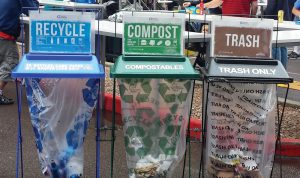BioCycle March/April 2015

MGM Resorts’ 13 Las Vegas resorts diverted a total of 25,398 tons of food from landfill to compost, a 50 percent increase over 2012.
MGM Resorts’ Food Recovery Accomplishments
MGM Resorts International received two national Food Recovery Challenge awards from the U.S. EPA for reducing food waste and, in the process, conserving natural resources. “MGM’s zero waste leadership has turned mountains of food scraps into compost to help fight waste and climate change,” said Jared Blumenfeld, EPA’s Regional Administrator for the Pacific Southwest. MGM Resorts (with 13 Las Vegas properties) and MGM Grand Las Vegas are two of the 32 recipients who received the 2014 Food Recovery Challenge Award, and the only recipients in Nevada. The award was given for achieving the highest percentage of potentially wasted food diversion and prevention.
MGM Resorts’ 13 Las Vegas resorts diverted a total of 25,398 tons of food from landfill to compost, a 50 percent increase over 2012. It dramatically increased food scrap to composting rates in guest dining facilities, and implemented diversion practices in its employee dining rooms, which serve more than 40,000 meals each day at no cost to employees. MGM Grand Las Vegas diverted 5,384 tons of food scraps to compost in 2013, an increase of 161 percent over 2012. MGM hotels and casinos in Las Vegas include the Bellagio, Excalibur, The Mirage, Monte Carlo, and New York-New York.
Reducing Wasted Food Could Save $300 Billion Annually
Reducing consumer food waste could save between $120 billion and $300 billion/year by 2030 according to a new report by WRAP (The Waste & Resources Action Programme) and the Global Commission on the Economy and Climate. Achieving this would require a 20 to 50 percent reduction in consumer food waste. According to the report, one-third of all food produced in the world ends up as waste, while the value of global consumer food waste is more than $400 billion/year. As the global middle class expands over the course of the decade, the cost could rise to $600 billion, notes the WRAP report, Strategies To Achieve Economic And Environmental Gains By Reducing Food Waste. WRAP also identifies significant opportunities to improve economic performance and tackle climate change by reducing the amount of food that is wasted in agriculture, transport, storage and consumption.
“The difficulty is often in knowing where to start and how to make the biggest economic and environmental savings,” explains Dr. Richard Swannell, Director of Sustainable Food Systems at WRAP. “In partnership with United Nations Environment Programme and the Food and Agriculture Organization, WRAP produced international guidance on how to achieve that through implementing effective food waste prevention strategies that can be used across the world.”

Together with the Arizona Super Bowl Host Committee and the National Football League, the City of Phoenix announced that it achieved a 73 percent waste diversion rate at the Verizon Super Bowl festivities that occurred leading into the Super Bowl on February 1.
Super Bowl Central Waste Diversion Rates
Together with the Arizona Super Bowl Host Committee and the National Football League, the City of Phoenix announced that it achieved a 73 percent waste diversion rate at the Verizon Super Bowl festivities that occurred leading into the Super Bowl on February 1, 2015. The city’s Kick the Waste initiative took place in Verizon Super Bowl Central, the 12-block perimeter in downtown Phoenix created to host a variety of family-friendly activities. Recycling and organics containers were placed throughout the venue. The Arizona Super Bowl Host Committee encouraged vendors within the 12-block perimeter to use compostable materials, such as paper cups and paper plates, when serving their food and beverages. The Phoenix Public Works Department hauled all materials from Verizon Super Bowl Central to the city owned 27th Avenue Transfer Station, where they were sorted and processed.
The Kick the Waste initiative allowed the city to test the operations of its pilot food waste and composting program for the first time. Thirty-two percent of the materials diverted were made up of food scraps and soiled paper. These are being composted in Phoenix’s new pilot composting facility and will be ready for use on city landscape and gardening projects in about three months. More than 120,000 aluminum beverage containers were recycled from Verizon Super Bowl Central — almost 11 percent of the solid waste removed from the event.
New Stats On Ocean Plastic
In 192 coastal countries, discarded beverage bottles, food wrappers, toys and other bits of plastic are making their way from estuaries, seashores and uncontrolled landfills to settle in the world’s seas. The quantity of plastic waste mismanaged on land that is ending up in the ocean has been a decades-long guessing game. Now, the University of Georgia’s (UGA) Jenna Jambeck and her colleagues at the National Center for Ecological Analysis and Synthesis working group have put a number on the global problem. Their study, reported in the February 13, 2015 edition of the journal Science, found between 5.3 and 14 million tons of plastic entered the ocean in 2010 from people living within about 30 miles of the coastline. That year, a total of 303 million tons of plastic waste was generated in those 192 coastal countries.
Jambeck, an assistant professor of environmental engineering in the UGA College of Engineering and the study’s lead author, explains the amount of plastic moving from land to ocean each year, using 8.8 million tons as the midpoint, “is the equivalent to finding five grocery bags full of plastic on every foot of coastline in the 192 countries we examined.” To determine the amount of plastic going into the ocean, the researchers began by looking at all debris entering the ocean from land, sea and other pathways. Their goal was to develop models for each of these sources. After gathering rough estimates, it fairly quickly emerged that the mismanaged waste and solid waste dispersed was the biggest contributor of all of them. From there, they focused on plastic.
This research primarily collected data on plastic that floats. Of the 5.3 to 14 million tons going in, researchers are only finding between 7,000 and 270,000 million tons floating on the ocean’s surface. “This paper gives us a sense of just how much we’re missing,” notes coauthor Kara Lavender Law of the Sea Education Association. “There is a lot of plastic sitting on the bottom of the ocean and on beaches worldwide.” Jambeck forecasts that the cumulative impact to the oceans will equal 171 million tons by 2025.










